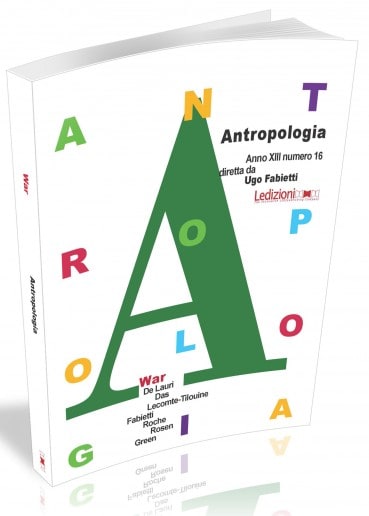De Lauri, Antonio, ed., 2013, “War”, Antropologia, Vol. 16, Milan.
135 pp., ISBN 978-88-6705-129-8
Although war and, more broadly, the ‘problem of violence’ have long been debated, war itself cyclically undergoes processes of euphemisation through which violence is rendered opaque, oxymorons are created (e.g. ‘just war’, ‘humanitarian war’) and democratic ‘audiences’ are made accomplices of ‘morally justified’ acts of violence.
This meaty little book challenges these simplifying rhetorics by providing a complex and multifaceted account of war and war-related phenomena and by questioning the contradictions of modern liberal discourses. As the editor states, in this volume no attempt is made at defining the ‘cause’ or ‘nature’ of war. Rather, all the contributors concur in destabilising «the certainty of positions that aim to define what war is», thus enlarging the «arbitrary delimitation of reality» provided by definitions (p. 18). The main aim of the volume is thus the study of war in terms of its discursive construction, implications, and cultural and social prerequisites (p. 9), in an attempt to fill the space between economico-political explanations and sociobiological assumptions (p. 19).

Finally, the cultural-critical approach of anthropology entails the support of a counter-rhetoric of war «that critiques the dominant rhetoric produced at both the mass media and specialised levels, which depicts war as a necessary evil» (p. 9). De Lauri argues that ‘indiscipline’, a critical category embodied in the political trope of the ‘undisciplined’ or ‘reluctant’ soldier, «may be seen as a useful instrument for the production of a counter-rhetoric of war» (p. 18).
Following this lead, the first chapter of the volume addresses the issue of non-cruelty. Analysing the great Sanskrit epic of Mahabharata, Veena Das highlights the contradictions of warfare, as displayed in the mythological imagination. At the overt level − she argues − the epic proposes a connection between sovereignty and the monopoly over violence, and presents war as a matter of justice, vengeance and display of heroic virtues. But within the story we can find an alternative perspective.
Das selects some scenes of the epic in order to emphasise the counter-rhetoric that runs under the main voice. A first insight leads us to consider ‘the loss of self’ as an essential corollary of warfare (p. 27). In the ‘dice game’ scene, gods do not offer any way out of war and are questioned by a woman. This unusual trope discloses a central feature of Das’ argument and the main interrogative of her contribution: «how those who are excluded from the political community come to have a place in the mythological imagining of warfare?» (p. 26). We need to seek the answer in the concept of non-cruelty − anrishamsya. Non-cruelty points to the experiences of intimacy, relationality, and togetherness, as the only way out of cycles of violence. Significantly, in the epic, this perspective is not suggested by gods, or by men, rather by «those who are excluded from the political community − women and animals, as well as earth itself» (p. 26).
Chapters 2 and 3 address the issue of sacrifice. Fabietti poses a clear-cut theoretical question: «Can suicide attacks carried out by Muslim men and women against military and civilian targets be considered acts of war and/or ‘religiously motivated’ sacrifices?» (p. 57). His complex and nuanced argument rests on a multilayered analysis of suicidal violence, both considered as a politico-military act and a form of social communication (p. 65).
Fabietti deliberately avoids any attempt to unravel the problem of the religious dimension of human bombing, proposing a shift in the focus of the debate. Human bombing − he argues − needs to be interpreted as having an underlying ‘sacrificial configuration’: a combination of violence with transcendency, which does not necessarily entail a religious dimension. ‘Transcendency’ is the ‘world of the invisible’ upon which the life of the community depends (p. 63). Yet, it emerges in the political relationship with an external enemy.
When the martyr undergoes a process of consecration, the contact with the transcendent dimension confers him a greater ‘strength’. This strength comes from the martyr’s community, which recognising his sacrifice and his authority obtains a heightened sense of collectivity and is exerted, in the suicidal act, against an external enemy. Thus, the sacrifice of the individual asserts the eternity of the group and fortifies it «in relation to the suffering endured at the hands of an enemy» (p. 64).
This ‘sacrificial configuration’ is given form and meaning within a peculiar historico-social context. This context is shaped by the ‘visual discourse’ of the media environment, which constitutes a public for the witnessing of faith of the human bomber and defines the importance of the politico-ideological framework of the jihad.
Lecomte-Tilouine moves on a different level. She investigates the frequency of the analogy between sacrifice and war in the Maoist ideology of the People’s War in Nepal. Her assumption is that collective forms of violence are to be conceived as a possible form taken by sacrifice. To demonstrate her point, she analyses the forms and meanings of sacrifice at two levels: the mythological one and that of ritual practices. At both levels, sacrifice acts as the organiser of caste society and it is also indicative of tensions internal to it: it puts on the stage the conflict between pure and impure castes, and thus reproduces the hierarchical organisation of the society.
For this reason, the sacrifice has an inherent political meaning, since it «exposes […] the violence of the group inflicted on itself», interpreted as «the ultimate test of group belonging» (p. 53). At this level, sacrificial violence produces unity, bringing together the whole society for a joint project which is prefigured in the act itself: sacrificial war. Once the group is unified, it leads «an equally violent and sacrificial campaign, but directed at an outside entity» (p. 53).
Given these premises, the Maoist revolutionary movement needs to be conceived in the combinatorial nature of two models of sacrifice: «the People’s War took its vocabulary from the war-like royal sacrifice, but combined it with the Brahmanic model of self-sacrifice» (p. 53) transposing violence from a sacrificial to a war-like context.
Both Fabietti and Lecomte-Tilouine question the theoretical status of sacrifice, engaging in an interesting dialogue with classical theories. On the one hand Lecomte-Tilouine criticises, among others, Girard’s theory of the ‘scapegoat’, stating that in the Nepalese case a) rivalry between men is not based on identity (thus is not mimetic) and b) blood sacrifice is not ‘containing’ (since it initiates violence). On the other, Bloch’s theory of the ‘rebounding violence’ stimulates a fertile dialogue with both contributions, proving that − as Fabietti argues − the comparative task of anthropology is not doomed to an epistemological nihilism (p. 57).
In chapter 4, Roche brings a command of history and ethnography to an examination of the Tajik post-civil war, investigating how categories of analysis and categories of practice are related to each other and by highlighting how the conflict has shaped these categories (p. 70). The author takes into account how the «ordering of civil war events by researchers and journalists according to specific features that were seen as the causes of the conflict» (p. 70) has explained the conflict through the notions of mahallgaroi and “violence specialists”. She argues that these categories have been used to establish processes of selfing and othering that heavily reshaped the everyday categories of practice, transforming «multiple and fluid groups into rigid group identifications» (p. 88).
The same sensitive attention to the role of violence in everyday life is explored in Green’s account of the Yup’ik combat soldiers of south-western Alaska. Green describes her interlocutors as people that «shoulder the burden of two wars»: a) a racialized class war and b) the hardships of combatants. On the one hand she attempts to «situate the experiences of deployment to war by Yup’ik men within a historical context of structural, symbolic and everyday violence» (p. 114). On the other she addresses two main motivational arguments that lead soldiers to join the army: their hope of creating a future for themselves and their families and their will to reinvigorate a shared cultural identity. Finally, she considers the difficulties of returning from war, describing «the sense of confusion, pain, grief and isolation from others that bears down relentlessly on the psyche and soul of a combat soldier […]» (p. 126).
Both Roche’s contribution and Green’s one pose the pressing question of how violence reshapes everyday life practices and common sense categories. A similar concern has been recently put forward by Gerd Baumann in his ‘Grammars of Identity / Alterity’. He poses the question of how − under the Nazi regime − ‘normal’ people acquiesced in the project of the Jewish mass annihilation. Convincingly, he demonstrates that it was a perverted use of language that seduced even the ‘initially innocent’ into complicity with genocidal policies and a politics of language that de-humanised the other. These contributions urge us to consider the problem of violence in the dynamics of its everyday production, in the sometimes opaque − although always pervasive − dimension of the ‘banality of evil’.
Finally, Rosen’s contribution shows how our «general understanding of the role of children in warfare has been seriously distorted by legal, humanitarian, and popular notions of […] childhood innocence distorted and subverted by adult culpability» (p. 108). He claims that this trope of childhood as the locus of innocence, vulnerability, and dependency is the byproduct of a 19th century cultural and legal shift. To support his claim he brings evidences from the 18th and early 19th century popular culture that describes the child soldier as an iconic symbol denoting public virtue and the nobility of sacrifice. Moving to the analysis of modern accounts of child soldiering and to the contemporary popular fictional literature, Rosen argues that, on the contrary, the contemporary iconic child soldier «serves as a symbolic proxy of the horrors of war» (p. 103).
Here we might ask: why does the trope of child soldiers is effective in raising a feeling of horror in Western audiences? Rosen’s hypothesis − I argue − is consistent with Talal Asad’s reflections on the feeling of horror, as exposed in his book ‘On suicide bombing’. Westerners’ reactions to child soldiers are in fact professions of horror, caused by the deliberate transgression of a peculiar boundary: that between childhood innocence and the terrifying dynamics of war. So construed, the trope of the child soldier is functional to political rhetorics that aim at distinguishing morally justified and unjustified wars.
All together, one of the main scopes of the volume seems to be strictly related to the transformative power of violence generated by war. The individual that comes within the force field of violence experiences a loss of self (Das); sacrificial violence structures the socio-political organisation (Lecomte-Tilouine) and adds a transcendental “strength” to the martyr (Fabietti); violence shapes everyday categories of practice (Roche) while framing life chances and expectations (Green). Overall, violence is a discursive construct that is itself transformed by our own cultural assumptions (Rosen).
In a counter-intuitive movement, war as such is given little attention in this volume. The editor has provoked a polyglot discussion to emerge, which befits its heterogeneous frontiers, rather than imposing a single model or trajectory. Consistently, the authors have chosen to engage in a debate where the wide range of ethnographic contexts (India, Tajikistan, Alaska) and the different levels of analysis (discursive, historical, ethnographic, theoretical) eventually return both the drama and the complexity of what we associate with war. This book should be of interest to ethicists, anthropologists, scholars of religion and violence. More broadly, given the key topic it addresses, the bok will speak to an audience interested in widening the conceptual boundaries of what we are used to define as ‘war’ and ‘violence’.



